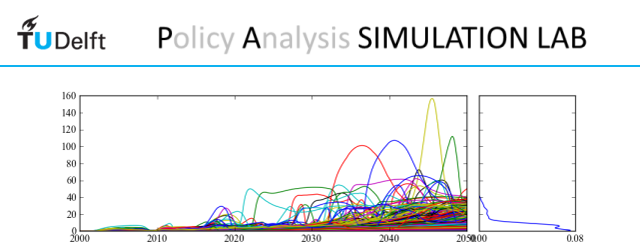

Here you can find detailed information about the current and past courses that are offered by the Faculty of Technology, Policy and Management of Delft University of Technology.
SPM2313: System Dynamics
SPM2313, the introductory SD course for bachelor students, focuses on introducing the theory of SD modelling. ‘Hot’ cases of 1-2 pages are used to demonstrate the use of SD in addressing current issues (Pruyt, 2009a, Pruyt, 2009b, Pruyt, 2010). These cases are embedded in a theoretical shell (see Figure below). The learning goals of the introductory SD course are:
Contact: Erik Pruyt
SPM2391: The SD Project Course
SPM2931 is the SD project course, following the Introductory SD course. Students build a SD model, based on a case description of a real societal problem and report on the development and use of their model to a fictitious client. In this way students are challenged to address real life complexity in a controlled setting. The academic skill of reflecting on a modeling study is also introduced (Slinger et al., 2008). The learning goals of the SD project course are:
Contact: Els van Daalen
In the bachelor thesis project (SPM3911) students can choose to apply the SD modeling method to a complex, multi-actor, societal problem of their own choosing. Whereas the initial analysis addresses the real world problem complexity, the final product and recommendations do not necessarily have to be used by a real life problem owner. The learning goals of the bachelor thesis project are:
Contact: All staff members
EPA1321: Continuous Systems Modeling: SD
EPA1321, the Continuous Systems Modeling combines the introductory System Dynamics course and the SD project course for EPA MSc students. ‘Hot’ cases of 1-2 pages are used in the first quarter to demonstrate the use of SD in addressing current issues (Pruyt, 2009, Pruyt, 2010). These cases are embedded in a theoretical shell (see Figure below). The learning goals of the introductory SD course are:
After passing the mid-term exam, students follow the SD project part of the course. Students build a SD model, based on a case description of a real societal problem and report on the development and use of their model to a fictitious client. In this way students are challenged to address real life complexity in a controlled setting. The academic skill of reflecting on a modeling study is also introduced (Slinger et al., 2008). The learning goals of the SD project course are:
Contact: Erik Pruyt, Jill Slinger
SPM9154: Advanced SD Course
SPM9154, the advanced SD course, aims at deepening the students’ theoretical and practice-based understanding of justifying, building, validating, analyzing and communicating systems dynamics models. Students are required to formulate a model of an ill-defined, real world problem. Students then apply for data structuring techniques, advanced verification and validation techniques and develop a strategy to communicate their model in a multi-actor setting. Certain of the techniques that the students study are ‘cutting edge’. For example the focus on formal model analysis, including eigenvalue elasticity analysis (Kampmann, 1996) and the development of an interactive learning environment as a model communication tool (Slinger et al., 2009). In addition, students are exposed to a series of lectures from practicing, Dutch system dynamicists, building their understanding of professional practice. The learning goals of the advanced SD course are:
Contact: Els van Daalen, Jill Slinger
Finally, if a student elects to use SD in their master thesis project (SPM5910) the doors are opened wide for full real world complexity. Students are expected to formulate a real life, multi-actor problem and to go through the whole modeling cycle independently. Usually the final product and recommendations are communicated and used by the actual problem owner, putting extra requirements on the use of the model and reporting of the results. Students are also expected to be able to reflect on their modeling in an academic mode of thinking. The SEPAM masters thesis project has the following objectives:
Figure: SEPAM SD Curriculum. Source: (Meyers et al. 2010)

Contact: All staff members